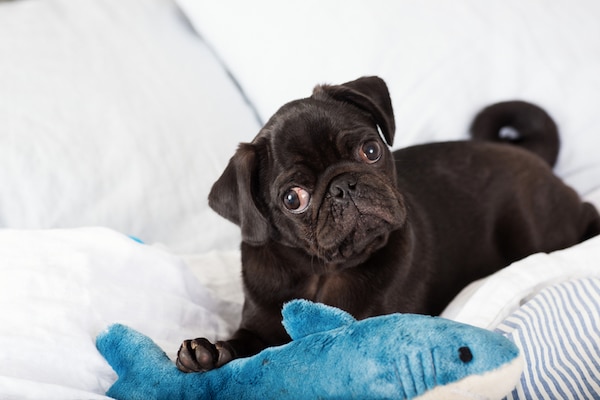Editor’s note: Have you seen the Dogster print magazine in stores? Or in the waiting room of your vet’s office? This article appeared in our December-January issue. Subscribe to Dogster and get the bimonthly magazine delivered to your home.
Resource guarding in dogs can be similar to what a toddler might do on a playground with other toddlers when he comes across something shiny, new, and at once coveted. Sometimes he’ll clutch the new object to his chest, announcing: “THIS IS MINE!!”
Dogs do something similar with objects and people, only instead of hollering, “This is mine,” some dogs crank up their communication and end up growling, snarling, or even biting to keep control of what they really, really want. Resource guarding could have a genetic component, and environmental factors can certainly play a role.
What can you do to help reduce the significance of the guarded object, place, thing, or person?
What not to do
First, let’s discuss what NOT to do: Never punish this behavior. It will make the guarding worse, will make your dog fear you and perhaps even attempt to increase his possessiveness over that which he really wants.
Keys to prevention
“Fix” this issue through prevention.
Make feeding time a happy-happy-joy-joy place wherein you walk past your dog eating out of his bowl and you drop some yummy treat into that very bowl.
Make it a habit to pick up the empty bowl throughout the day, put a tasty morsel in it, and place it back on the floor for your dog, making sure he has been watching you do this.
Practice “exchanges” with your young dog. For example, don’t rip the tissue box away from him when he counter surfs it off the table. Instead, approach him with something he wants more — and something you approve of him having — and trade him out. Then push everything back out of reach on your counter tops as you are teaching your dog not to jump on them.
Soft signs of guarding

Pug with paw on toy by Shutterstock.
If you see “softer” signs of guarding, like turning his body away from you while chewing on the object or putting it under his paw, help your dog come to a new understanding of what these coveted things mean and what will happen when another dog or human approaches when he has those things in his possession.
Thanks to endless scientific study, we know that we can change a dog’s internal emotions, but it requires good human timing. In essence, we want the coveted item to predict more yummy things whenever that item or person is present.
For example, a dog is growling at a husband when he comes too close to the wife (the dog’s main resource if she spends the most time with him, feeds him, takes him on walks, etc.). This is not behavior we punish, as it works against you in changing the dog’s opinion of what the husband getting close to him or his favorite resource means. It also makes the dog distrust the man even more!
Instead, work from a distance at first. When the husband comes into the room, have a new method of greeting the dog. I love the “Find it!” game where the human throws tasty morsel after tasty morsel on the floor and asks the dog to find each one. Soon enough, the dog who was growling at the husband begins to eagerly anticipate him and that super fun game. You can do the same with a game of fetch the tennis ball if your dog loves to fetch.
Don’t rush or crowd your dog. If you aren’t making fast headway, call in a professional. A dog is unlikely to grow out of resource guarding, and he needs smart human guidance to help move past it.
Resource guarding is a natural tendency. Humans do it, too, but we have the benefit of talking it through with one another. Instead of getting into a fight with a non-verbal species over an object, person, or place, set about changing the dog’s emotions about that thing. This way, everyone wins.
If your dog already exhibits pronounced resource guarding:
- a hard stare
- body stiffness
- growling
- snarling
- air snapping
the best course of action is to bring in a qualified, experienced, truly force-free dog training professional to assist you.
Top photo: Dog with bowl by Shutterstock.
The post How to Deal With a Dog Who Guards Food, Toys, Places, or People appeared first on Dogster.
No comments:
Post a Comment